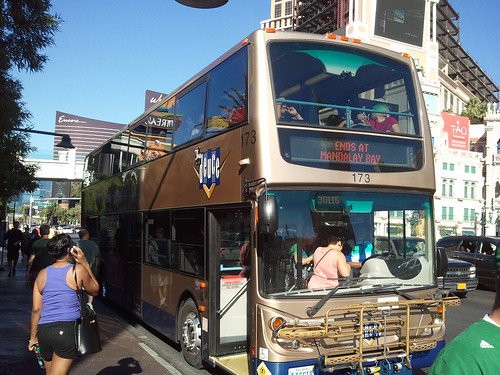Thursday, October 28, 2010
Vegas Travelogue, Part 3: Vegas Transit
(You can also catch parts 1 and 2 of my Vegas travelogue, which mostly consist of me griping about traffic.)
Las Vegas is a strange, libertarian fantasyland. Everything on the Strip gleams in bright, shining neon and marble, with clean, well-maintained sidewalks, roads and bridges. Get a block away and the sidewalks are cracked, the streets lined with vacant lots and run-down apartments. The power relationships of the city are written right there on its urban form. But, interestingly enough, the region has a pretty extensive transit system. Because of the significant demand of drunken tourists and low-wage hospitality workers, the all-bus system runs frequently, all day and every day.
It also has the unique characteristic of charging more for visitors than locals, at least along the Strip. The two Strip services, the ACE Gold Line and the Deuce (express and local, respectively), charge a higher fare for out-of-town visitors than they do for Clark County residents.
Anyway, down to the nitty-gritty. The Strip has two services that run along it- the Deuce (local) is a set of double-decker buses (pictured above) that run every 10-20 minutes, 24 hours a day. The ACE Gold Line is a new bus rapid transit system that links downtown Las Vegas with the Strip and the McCarran Airport. Both services share stops and ticket vending machines along the Strip.
Off the strip, the RTC system is mostly a grid-based system, with a sensible numbering system. 100-series routes run mostly north-south, with numbering starting with 101 in the west and moving up as the routes serve further eastward streets. 200-series routes run mostly east-west, starting at 201, with higher numbers moving northwards. Many trunk line routes run at 10-15 minute frequencies, and much of the system is 24 hours a day, 7 days a week.
So how well does this all work? We stuck around our hotel on Tropicana, a block over from the Strip, and on the Strip itself most of the time. Travelling northbound on the Strip, and off the Strip, was fantastic. Travelling southbound, which we always seemed to do at rush hour, was a nightmare. There was construction at the Bellagio, cutting off just one lane of the 8 lane Strip- and it made traffic a festering hellhole of despair. Furthermore, the stop at the Bellagio was meant to be a stop both for the Deuce and ACE lines, but the ACE line passed us up several times with no more than a fare-thee-well. It seems that the stop was too short for the articulated ACE buses, but no notification to that effect was posted.
The ACE Gold Line buses, however, weren't immune to these horrible traffic maladies. It seems to me that what the Strip really needs is bus lanes. North of the Strip, the ACE runs in a centre-median busway, separated from traffic. In the most traffic-choked parts of the city, though, the bus lanes disappear when they are most needed.
Beyond the transit troubles caused by the construction, it occurred to me that never before have I seen so very many people walking in such a terribly bad pedestrian environment. You see, most intersections on the Strip lack crosswalks, or only have them on one side. There are these pedestrian bridges at most major streets. The trouble with transit in the area, though, is that the grid system necessitates transferring between stops on different corners of the street. Even when they're on the same side of the street, it can be a quarter-mile walk between them. The fact that people nevertheless walk and use transit is an impressive statement of the willingness of people to avoid their automobiles while on vacation, or to the poverty and desperation of hospitality workers in Las Vegas.
Labels:
politics,
transit stories
Subscribe to:
Post Comments (Atom)




2 comments:
I've got to give them props on "The Deuce" just from a quality of nomenclature perspective. I'd be happy to drop a Deuce into LA's transit system, just for the novelty of a double decker bus :)
The one time I rode transit in Vegas I noticed two things (totally anecdotal): bus shelters were not universal despite the mind-boggling summer heat, and some of those lines have video screens that show you where you are in the route.
Chewie- the shelter problem is also evidence of substantial inequities. The Strip has shiny, tourist-friendly shelters with ticket machines and plentiful information. One block away, you're lucky if the bus stop has its own pole. (Some were simply tied to power line poles.)
Post a Comment